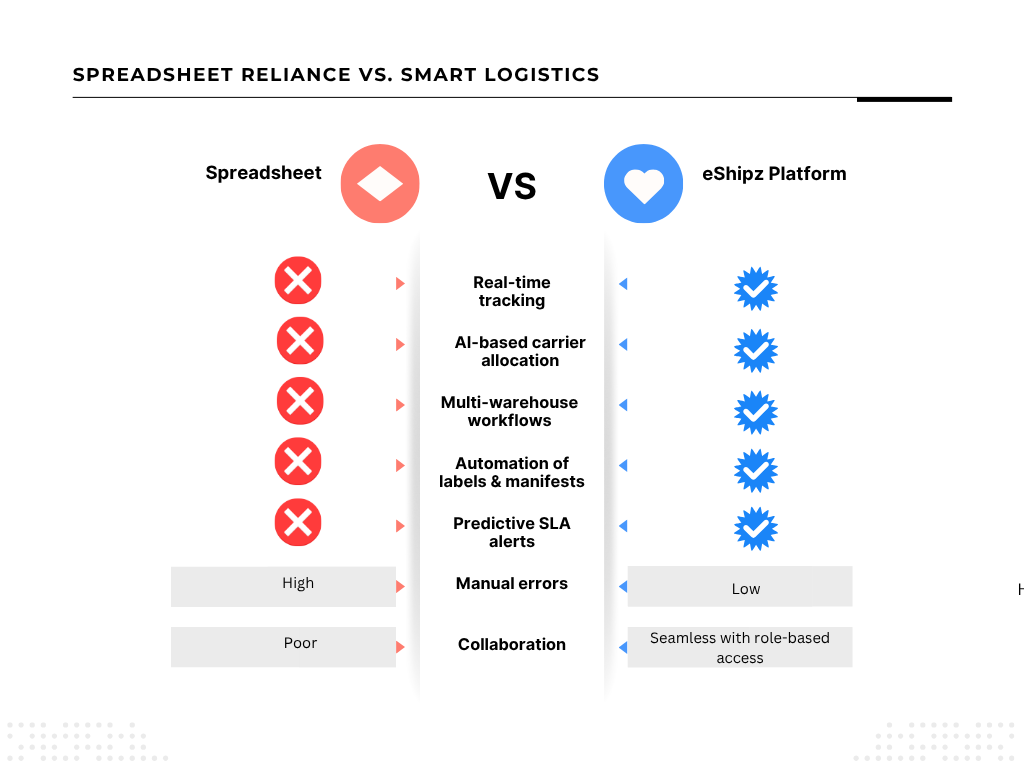In the world of fast-paced logistics and high-volume shipping, speed, accuracy, and efficiency aren’t just goals—they’re survival tactics. And yet, many growing businesses still rely on Excel spreadsheets to manage critical shipping automation. What appears to be a flexible, low-cost solution on the surface is, in reality, a silent killer of efficiency, profits, and customer satisfaction.
This blog will explore the hidden costs and risks associated with spreadsheet-based shipping operations, and how modern logistics automation platforms like eShipz can eliminate inefficiencies, reduce costs, and future-proof your shipping strategy.
Why Spreadsheets Are Still Popular for Logistics Management
Spreadsheets have been a go-to tool for logistics managers because they are readily available, easy to use, and familiar.
Businesses use Excel or Google Sheets to:
- Track orders and shipping statuses
- Maintain carrier rate tables
- Plan and assign deliveries
- Reconcile shipping data for reports
But as your shipment volume grows, these spreadsheets begin to break under pressure. Here’s why:
- Human error: Manually entering data leads to frequent mistakes, from incorrect addresses to missed updates.
- Lack of real-time updates: Spreadsheets are static. There’s no real-time integration with carriers or order systems.
- Poor collaboration: Multiple team members editing a single spreadsheet can lead to version conflicts and data overwrites.
- No scalability: Spreadsheets might work for 10 orders a day. But 100? 1,000? They’re simply not built for scale.
According to a 2024 Deloitte report on supply chain digitization, companies relying on manual systems face a 23% higher rate of order inaccuracy than those using automation.
The Hidden Cost of Spreadsheets in Logistics
Continuing to manage logistics with spreadsheets is like using paper maps for last-mile delivery—you might reach your destination, but with delays and detours.
Here are some of the hidden costs:
1. Operational Inefficiency Spreadsheets require time-consuming manual updates, slowing down your shipping cycle. Teams can spend 4–6 hours a day just updating and cross-verifying data.
2. Increased Errors Manual data entry leads to 20–30% more errors, which means incorrect deliveries, unhappy customers, and increased returns.
3. Lack of Real-Time Visibility Spreadsheets can’t provide live tracking or SLA adherence, making it impossible to spot and resolve issues proactively.
4. Lost Revenue Opportunities Without automation, you’re likely missing out on cost savings from smart carrier selection, or repeat sales from better post-delivery engagement.
5. Poor Inter-Departmental Coordination Data is siloed, and syncing across departments takes 2–3 hours/week, leading to misalignment between sales, support, and operations.
Smarter Logistics with eShipz — A Better Alternative
At eShipz, we understand the unique pain points that come with scaling logistics operations—manual bottlenecks, rising shipping costs, and a lack of real-time visibility. That’s why we’ve developed a powerful logistics and shipping automation platform built specifically for fast-growing brands that need speed, accuracy, and agility across the supply chain.
Key Features That Replace Spreadsheets Entirely:
- AI-Driven Shipment Planning
eShipz automates carrier allocation based on weight, value, service mode, regional carrier performance, and pincode/state-specific rules. - Carrier Selection Engine
Integrated with 400+ carriers, the platform auto-selects the best option based on dynamic business rules. - Automated Workflows
From multi-warehouse operations to auto-generating manifests and labels, eShipz streamlines every step.
Here’s what our customers have experienced
Spreadsheet Reliance vs. Smart Logistics — A Quick Comparison

- 70% faster shipment planning through automation and AI-based route logic.
- 30–50% time savings on carrier assignment and documentation.
- 4–6 hours saved daily for teams handling 100+ shipments.
- 20–30% fewer manual planning and data entry errors.
- Better SLA adherence with predictive insights from our Control Tower view.
- Improved CX with fewer delivery errors and faster support responses. Check the latest Trends re-shaping shipping & logistics in 2025
- 25% drop in RTOs after automating their shipping workflows By removing spreadsheet dependency, they scaled operations across 5 warehouses while reducing manpower.
A leading fashion retailer saw a 25% drop in RTOs after automating their shipping workflows with eShipz. By removing spreadsheet dependency, they scaled operations across 5 warehouses while reducing manpower.
Step Into the Future of Shipping Automation
With rising delivery expectations, tighter margins, and omnichannel complexity, spreadsheet-led ops are simply unsustainable. Platforms like ClickPost or Locus offer solid logistics orchestration, but eShipz stands out with a purpose-built suite for mid-market and enterprise brands, especially in D2C, fashion, and retail segments.
What’s more, eShipz supports post-delivery engagement and returns management, ensuring you don’t just deliver better—you also build customer loyalty. With eShipz, you gain a logistics partner that brings intelligence, automation, and scale to your shipping operations.
Explore how eShipz can transform your shipping ops today. Schedule a Demo

